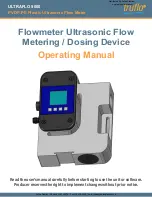
Installation
1-5
SRS Residual Gas Analyzer
Wear gloves!
Do not talk or breath directly into the probe’s ionizer.
Use clean tools during the installation procedure!
i
Protect the integrity of the Vacuum seals:
Do not use nonmetal seals.
Avoid scratching the metal seals.
i
Verify that the vacuum port is electrically grounded before attempting the installation
of the RGA Probe on the vacuum system.
Hardware Requirements
1. Do not operate the SRS RGA in corrosive gas environments. If the presence of
corrosive gases in the vacuum environment is known or suspected, consult SRS
before installing the probe in the vacuum chamber.
2. Do not operate the SRS RGA in the presence of strong magnetic fields. Magnetic
fields, such as those caused by superconducting magnets or cold cathode total
pressure gauges (i.e. Penning type), can affect the ion trajectories through the
quadrupole filter resulting in very unreliable measurements. If the presence of
magnetic fields in the vacuum environment is known or suspected, consult SRS
before mounting the probe on the vacuum chamber.
3. The maximum operating pressure of the RGA is 10
-4
Torr. A pressure reduction
system is required if the operating pressure of the vacuum chamber is greater than
10
-4
Torr. Consult Appendix B of this manual for details.
4. The probe can be mounted directly onto any standard 2 3/4" CF port of a vacuum
chamber provided the following placement requirements are met:
x
The vacuum port must have at least 1.375” internal diameter and 2.5” depth to
provide enough clearance for the ionizer (The insertion volume is comparable to
that required by a nude Bayard-Albert ion gauge).
x
Any mounting orientation of the probe may be used.
x
The ionizer is the only component of the probe that protrudes into the vacuum
system and it must be located close to the point where partial pressures are to be
measured. If placed near a pump, the pressure in the ionizer may be considerably
lower than in the rest of the system. If placed near a gas inlet or source of
contamination, the pressure in the gauge may be much higher. Long tubulation or
other constrictions between the ionizer and the rest of the vacuum system can
cause large errors in the partial pressure readings.
x
The probe must be distanced or shielded from all other instruments that could
potentially affect the RGA readings. For example, cross-talk with hot-cathode ion
gauges is possible but easily eliminated by proper shielding or changes in the
relative placement of the gauges.
x
The probe must be protected from evaporation sources that could coat the
ionizer.
Содержание RGA100
Страница 4: ...SRS Residual Gas Analyzer iv...
Страница 18: ...xviii Command List SRS Residual Gas Analyzer...
Страница 46: ...2 14 Residual Gas Analysis Basics SRS Residual Gas Analyzer...
Страница 66: ......
Страница 78: ...4 12 Mass Filter Power supply SRS Residual Gas Analyzer...
Страница 104: ......
Страница 107: ...Programming the RGA Head 6 3 SRS Residual Gas Analyzer Error Byte Definitions 6 69...
Страница 216: ...8 26 Quadrupole filter cleaning SRS Residual Gas Analyzer...
Страница 246: ...11 2 SRS Residual Gas Analyzer...
Страница 247: ......
Страница 248: ......
Страница 268: ...Appendix B SRS Residual Gas Analyzer 7...
Страница 310: ...Appendix D SRS Residual Gas Analyzer 25 Select TCP IP and click the Properties button to find the IP address...
Страница 312: ...Appendix D SRS Residual Gas Analyzer 27...
Страница 313: ...28 Appendix D SRS Residual Gas Analyzer...
















































